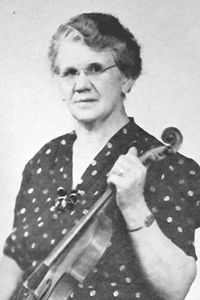Annotation:Muddy Water (1): Difference between revisions
No edit summary |
m (Text replacement - "garamond, serif" to "sans-serif") |
||
| Line 1: | Line 1: | ||
=='''Back to [[{{BASEPAGENAME}}]]'''== | =='''Back to [[{{BASEPAGENAME}}]]'''== | ||
---- | ---- | ||
<p><font face=" | <p><font face="sans-serif" size="4"> | ||
'''MUDDY WATER [1].''' AKA and see "[[Durroch's Hornpipe]]." Old-Time, Breakdown or Reel. D Major. Standard tuning (fiddle). AABB. Bayard (1944) once thought this tune a version of the Irish Jig "[[Walls of Liscarroll (The)]]," but later (1981) reconsidered that it was rather a version of the Pennsylvania tune "[[Durroch's Hornpipe]]" (derived from the Irish "[[O'Dwyer's Hornpipe (1)]]"). It has been suggested (by, for one, Louie W. Attebery in his article "The Fiddle Tune: An American Artifact" {1979}) that the name change from "Walls of Liscarroll" to "Muddy Water" came about in a process of naturalization due to anti-British sentiments during the War of 1812. | '''MUDDY WATER [1].''' AKA and see "[[Durroch's Hornpipe]]." Old-Time, Breakdown or Reel. D Major. Standard tuning (fiddle). AABB. Bayard (1944) once thought this tune a version of the Irish Jig "[[Walls of Liscarroll (The)]]," but later (1981) reconsidered that it was rather a version of the Pennsylvania tune "[[Durroch's Hornpipe]]" (derived from the Irish "[[O'Dwyer's Hornpipe (1)]]"). It has been suggested (by, for one, Louie W. Attebery in his article "The Fiddle Tune: An American Artifact" {1979}) that the name change from "Walls of Liscarroll" to "Muddy Water" came about in a process of naturalization due to anti-British sentiments during the War of 1812. | ||
<br> | <br> | ||
<br> | <br> | ||
</font></p> | </font></p> | ||
<p><font face=" | <p><font face="sans-serif" size="4"> | ||
[[File:armstrong.jpg|200px|thumb|left|Sarah Armstrong]] | [[File:armstrong.jpg|200px|thumb|left|Sarah Armstrong]] | ||
''Source for notated version'': Mrs. [[biography:Sarah Armstrong]] (Derry, Pa., 1943) [Bayard]. | ''Source for notated version'': Mrs. [[biography:Sarah Armstrong]] (Derry, Pa., 1943) [Bayard]. | ||
| Line 12: | Line 12: | ||
<br> | <br> | ||
</font></p> | </font></p> | ||
<p><font face=" | <p><font face="sans-serif" size="4"> | ||
''Printed sources'': Bayard ('''Hill Country Tunes'''), 1944; No. 43. | ''Printed sources'': Bayard ('''Hill Country Tunes'''), 1944; No. 43. | ||
<br> | <br> | ||
<br> | <br> | ||
</font></p> | </font></p> | ||
<p><font face=" | <p><font face="sans-serif" size="4"> | ||
''Recorded sources'': <font color=teal></font> | ''Recorded sources'': <font color=teal></font> | ||
</font></p> | </font></p> | ||
Revision as of 14:27, 6 May 2019
Back to Muddy Water (1)
MUDDY WATER [1]. AKA and see "Durroch's Hornpipe." Old-Time, Breakdown or Reel. D Major. Standard tuning (fiddle). AABB. Bayard (1944) once thought this tune a version of the Irish Jig "Walls of Liscarroll (The)," but later (1981) reconsidered that it was rather a version of the Pennsylvania tune "Durroch's Hornpipe" (derived from the Irish "O'Dwyer's Hornpipe (1)"). It has been suggested (by, for one, Louie W. Attebery in his article "The Fiddle Tune: An American Artifact" {1979}) that the name change from "Walls of Liscarroll" to "Muddy Water" came about in a process of naturalization due to anti-British sentiments during the War of 1812.

Source for notated version: Mrs. biography:Sarah Armstrong (Derry, Pa., 1943) [Bayard].
Printed sources: Bayard (Hill Country Tunes), 1944; No. 43.
Recorded sources:
